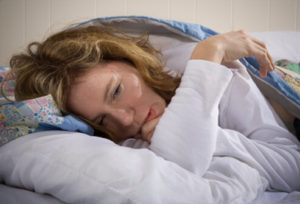 When Depression Doesn’t Get Better
When Depression Doesn’t Get Better
When you’re sick of one more trial. One more dose increase. A new augmentation agent. Another cross taper…reducing dosage on one drug while increasing it with another… When you’re sick of just feeling so sick and tired and miserable. When you can’t stand the thought of gaining more weight. What then?
With the rising use of IV ketamine infusions for treatment-resistant mood disorders, more and more people who are sick of their symptoms are seriously stopping and thinking about their best course of action. Since oral antidepressants can take weeks – if not months – for their full benefits, people are looking at brain-targeted treatments that have faster results.
Life Threatening Symptoms
One reason is that the suicidal thinking that can occur with depression can be life-threatening. If you have thoughts that it would be a relief to be dead, or thoughts of killing yourself, waiting 2-3 months for oral medication to kick in and relieve these thoughts can be dangerous.
Another reason is that once you reach the point that you’re looking for alternatives to oral antidepressants, you’ve probably been depressed for months or years. And the longer it goes on, the more life-robbing it becomes.
Then, there are studies that show the longer someone suffers from a psychiatric mood disorder, the harder it is to get better. And the more  medications you try . . . the less likely that another SSRI (selective serotonin reuptake inhibitor) or SNRI (serotonin-norepinephrine reuptake inhibitor) is going to help.
medications you try . . . the less likely that another SSRI (selective serotonin reuptake inhibitor) or SNRI (serotonin-norepinephrine reuptake inhibitor) is going to help.
So you try a different class. You take one of the medications on reserve that we pull out when other things don’t work.
. . . And your symptoms slowly become “treatment-resistant” — even though you take what you’re supposed to take, do what you’re supposed to do. You keep every appointment, try to exercise, meditate in the morning. Sometimes nothing seems to make a difference. It’s exhausting even thinking about it.
These are all reasons to shift to a different treatment … an innovative one that can go above and beyond oral antidepressants.
Now wait just a minute… oral antidepressants help lots of people…!
Yes. They do. Millions.
Actually, 350 million people in the world are depressed.
16 million in the US.
4% of kids between ages 8-15 are, too.
Anxiety disorders are the most common mood disorder in the US — and 18% of adults suffer from anxiety disorders … almost 57,000,000 people.
Shocking, isn’t it?
Anxiety is the most widespread of all…
Every single one of these millions of people struggles and the struggle is real. Sometimes it’s just to get out of bed in the morning, sometimes it’s being paralyzed by a vague fear, sometimes it’s just to follow through and do what they know they should do — make the phone call, finish cleaning up the yard, deal with the paperwork. They can be pretty disabled by malfunctions in specific portions of their brain. Is it any wonder that so many take antidepressants hoping for relief that will allow them to function?
Most just want to be able to get back in the game.
Over 10% of Americans take antidepressants for depression and anxiety.
And we know that they’re really helpful for some people.
Just not all…not by a long shot.
Only HALF the Time
Jennifer Payne, M.D. is director of the Women’s Mood Disorders Center at The Johns Hopkins University School of Medicine — my alma mater. She says, “Even our best antidepressants work only about half the time.” And she goes on to say that the chance of success drops if the patient doesn’t respond to the first drug they try. In fact, the hope of recovery diminishes with each new antidepressant regimen that fails.
Their mood disorder slowly becomes “treatment-resistant,” even if they’re not. It’s for those who still suffer that we’re discussing options today.
Like IV ketamine, TMS, and ECT.
ECT – Its Troubling Side Effect
 Until recently, after all the failed med trials, the gold standard for treatment-resistant depression was ECT, or Electroconvulsive Therapy. (The snazzier new term for it is Electrocortical Therapy. They took out the “convulsive” part.)
Until recently, after all the failed med trials, the gold standard for treatment-resistant depression was ECT, or Electroconvulsive Therapy. (The snazzier new term for it is Electrocortical Therapy. They took out the “convulsive” part.)
ECT has been in use in psychiatry for over 80 years, and it’s still available at hospitals for inpatient and outpatient treatment. Although it gets a bad rap in the popular press and in the media, it can be a lifesaving, effective treatment for severe depression and particularly for depression when psychotic symptoms are present — like hearing voices, or having delusional beliefs.
With ECT, you’re given general anesthesia and an electric current is passed through your brain to create a generalized seizure that lasts 30-45 seconds under very controlled circumstances, with muscle relaxers. The seizure is “seen” on an EEG monitor but your body doesn’t shake or convulse — just a toe wiggles. Treatment begins in a hospital center after you’ve been admitted as an inpatient and continues three times a week until the depression lifts–sometimes after 4 or 6 or 12 treatments.
ECT may be continued on an outpatient basis and stretched out and administered on a maintenance schedule (sometimes as infrequently as once a quarter) to help preserve remission.
Sometimes, ECT is offered on an outpatient basis to patients who can safely remain at home with family support — but they usually can’t work or go to school or drive during the weeks of treatment.
Clinical studies show this treatment to be 50-80% effective in reducing depression symptoms, and in those cases the patient feels much better. Because of this, ECT has been the “go-to” treatment for those with treatment-resistant mood disorders for whom no antidepressant regimen was successful for many, many years.
But there’s a problem with ECT.
Despite all of the modern advances in the administration of this treatment, ECT can inhibit the ability to lay down new memories around the time period of the treatment, and it can cause irreversible memory loss in a “piece-y” kind of way.
Bits and pieces of memories are lost. Certain things or certain periods seem fuzzy. It’s frightening because it can involve both recent and remote memory.
Well, when you’re at the end of your rope, when it feels like there is no choice, maybe a little bit of fuzzy thinking or poor recall around the time of ECT doesn’t seem like such a big deal . . .
But if you want to go to a wedding, recall a client’s name or the details of a contract, have an important discussion with your wife (or your accountant), drive to your cousin’s summer place without having to use a GPS … then fuzzy thinking, poor recall, or no memory of it at all are incredibly BIG things. It’s to be able to engage in and savor the moments that you’re getting treatment in the first place.
Remember, ECT was the “go-to” alternative treatment for treatment-resistant mood disorders because there was no real alternative.
Until now.
Now, there are more options, like TMS and IV ketamine infusions.
TMS Offers A Strong Success Rate And It’s Non-Invasive
TMS, or Transcranial Magnetic Stimulation, is a non-invasive treatment option that’s become more and more  prominent in recent years. It’s more expensive than meds, but it’s effective for treatment-resistant depression as well other mood disorders and other maladies.
prominent in recent years. It’s more expensive than meds, but it’s effective for treatment-resistant depression as well other mood disorders and other maladies.
It’s Non-invasive. Nothing enters your body.
In this case, you’re is seated in a comfortable reclining chair – fully awake – because there’s no need for sedation. A magnetic coil is placed over your left temporal lobe just over the dorsolateral prefrontal cortex … and it sends pulses through your scalp into brain centers just below the surface. The pulses stimulate brain cells to send signals deep into the brain to activate, restore, and bring balance to the areas of the brain that control mood and anxiety.
TMS can be effective in 55-75% of people with treatment-resistant depression and other mood disorders. Because it’s non-invasive, there is nothing that lingers in the body to create lasting side effects between treatments or in the long-term. The effect that’s sometimes reported is a headache in the area where the tap tap tapping is heard when the impulses are released. This subsides in a little while.
No memory loss.
Great success in reversing depression.
No need for hospitalization… no need to suspend driving… no need for a leave of absence from work or from school like with ECT — even outpatient ECT.
For so many reasons, and for so many people, TMS is a much better alternative than ECT, which has become a last resort.
But there’s more… and I’ve probably saved the best for last.
TMS is effective, comfortable, and safe.
But there’s another option that’s even more effective.
That’s IV ketamine treatment for depression and other mood disorders.
IV Ketamine Can Replace Last Resort Treatments
Ketamine infusions are best given IV to ensure safety and to guarantee bioavailability — so that 100% of your precise dose (down to a tenth of a milligram) quickly reaches the areas of the brain and can get right to work. Like ECT and TMS, it’s recommended for those who have first tried an oral antidepressant without improvement.
You’re seated in a comfortable reclining chair (or maybe stretched out on a leather sofa!) in relaxing surroundings during the infusion. This treatment  is so fast and effective, many patients are feeling better by the time the infusion is over.
is so fast and effective, many patients are feeling better by the time the infusion is over.
Ketamine also treats suicidal thinking, basically erasing suicidal thoughts within 4 hours. This life-saving feature makes it a most desired choice for those who are are suicidal.
It’s a breath of fresh air. For some people, it feels like their first breath.
IV ketamine is typically given in the office as a series of six 40 minute infusions over about 2-3 weeks. And then you walk out … and go to dinner, get some sleep, and drive yourself to work the next morning or scoot off to class. There’s no hospitalization, no lost time. At Innovative Psychiatry, we schedule ketamine infusions in the evenings, so you don’t have to miss work or school. No one needs to know.
Like TMS, there are no side effects between infusions. There’s no memory loss. Period. That’s HUGE. During an infusion, you might experience mild nausea, so we just plan to avoid that altogether for you. There’s also a floaty, dissociative effect during an infusion — you should expect this. Most people find it very pleasant , not frightening, and it’s actually predictive of a good response to treatment.
Of course, there are other rare side effects of ketamine when it’s used in high doses in anesthesia. But we just don’t see them in our practice.
The effectiveness rate of IV ketamine infusions in our practice is 80%. That means that 80% of people who come in with treatment-resistant depression can get WELL. Depression symptoms disappear. For some people, maintenance infusions are used to maintain this wonderful, balanced, quality of life.
Joie de Vivre – the Joy of life.
If you’ve struggled to break out of the hollow, dismal, dark place of depression, consider this thrilling treatment. It can fill you with HOPE, then transform that hope to real, here-and-now, life-joy.

For us, it’s exciting to see people who have been so terribly ill come to life again. Live again. Love again.
The old days of suffering…without hope… are behind us.
There is hope for you, even if you haven’t been helped by antidepressants before.
Let’s meet and discuss new options.
To the recovery of your best self,
Lori Calabrese, M.D.

Ketamine infusions are working for me.
My depression was so extreme that only a very powerful sense of duty to my family was keeping me alive.
My depression was of more than 7 years duration, concurrent with severe unrelenting pain from an injury sustained during an assault. Maybe I should not have fought back against the giant man who attacked me; maybe then my back would not have been so badly injured. But of course I fought back. I didn’t think about the consequences to my body of fighting a man who outweighed me by 100 lbs of muscle, I was too enraged that the bastard had grabbed me to be scared. I should have been scared. I have been in pain every day since January 2010. I have lost my job, my profession.
I’ve been ‘trialed’ on more than six antidepressants (of various classes) since January 2010. Nothing was working at all anymore, and the side effects had become ghastly. I cried until I finally reached the point several months ago where I could no longer cry although I desperately craved the temporary relief tears would give me.
My most recent prior psychiatrist told me that ECT would not cause memory loss. I knew that was just not true. I fired that psychiatrist.
I had the 4th of the series of six ketamine infusions yesterday. My depression is half of what it was, in spite of the fact that my back pain is, unfortunately, pretty much as bad as ever. I used to be a very active sportswoman, and being forced into giving that up had made my depression worse. All I can do now is walk for exercise (which somehow I kept on during throughout all but the very worst times in the last 7 years, heaven knows how). No running. No skiing. No backpacking into the wilderness.
Well, my BACK is not better, but my BRAIN is. My thinking ability is back to normal already. I can now amuse myself with my intellectual hobbies again – particularly linguistics and foreign languages – and learn new and difficult things in my professional field again.
Ketamine infusions are very expensive but fortunately for me, I had the money available to spend. I don’t think that money would have helped my family very much if I had killed myself.
Marie